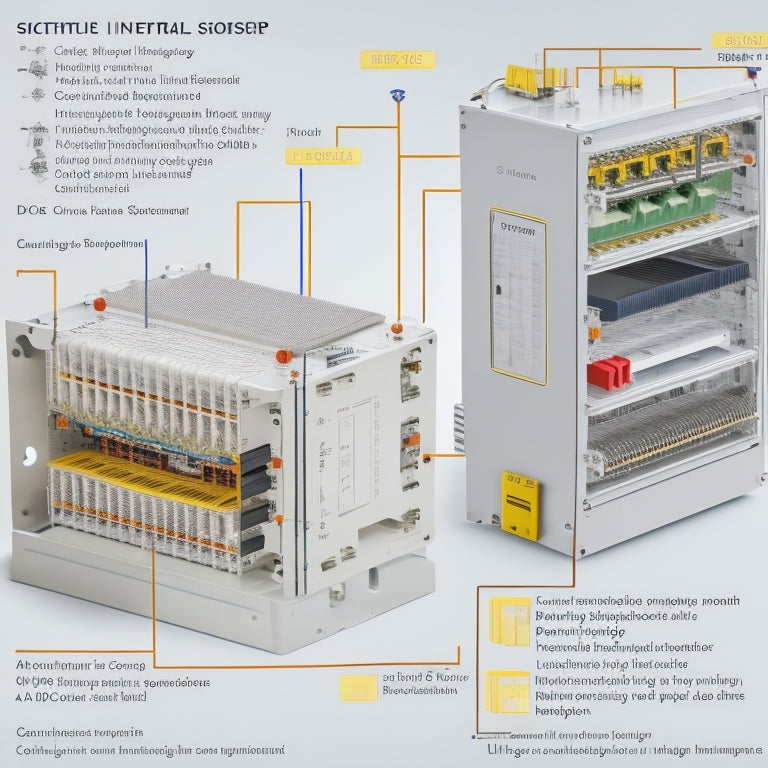
7 Essential Inverter System Components Explained
Share
You're about to learn how the 7 essential components of an inverter system work together to maximize energy harvest, guarantee reliable operation, and provide efficient power conversion. The DC-DC converter matches input voltage to load requirements, while the maximum power point tracker (MPPT) optimizes solar panel energy harvesting. The inverter bridge configuration determines overall system performance, and the isolation transformer design minimizes energy losses. Meanwhile, the ground fault detection system safeguards against electrical hazards, and the monitoring and control unit enables real-time system monitoring. Finally, the surge protective device protects against voltage spikes and grid faults. As you investigate these components, you'll uncover the intricate details that bring them together in harmony.
Overview
- A DC-DC converter is crucial for matching input voltage to load requirements, ensuring high efficiency and optimal energy harvesting.
- Maximum Power Point Tracking (MPPT) optimizes solar panel energy yield by up to 30% through continuous monitoring and adjustment.
- Inverter bridge configuration significantly influences power quality, efficiency, and reliability, making proper selection crucial for specific applications.
- Electrical isolation and voltage regulation are ensured by an isolation transformer design, which minimizes energy losses and promotes overall system performance.
- A monitoring and control unit enables real-time performance tracking, issue response, and data logging for optimized inverter system operation.
DC-DC Converter Functionality
Most inverter systems rely on DC-DC converters to step up or step down the voltage level of the input power source to match the requirements of the load.
As you design your inverter system, you'll need to guarantee the DC-DC converter can handle the input voltage range and provide the required output voltage. An efficiency analysis will help you enhance the converter's performance.
Load matching is critical, so you'll need to take into account thermal management and circuit protection to prevent overheating and damage.
When evaluating DC-DC converters, consider the inverter's energy requirements and sizing to guarantee peak performance. Additionally, focus on high peak efficiency ratings, typically above 98%, for maximum energy harvesting.
Component integration and control algorithms will also impact the converter's reliability factors and compliance with safety standards.
Maximum Power Point Tracker
You'll now investigate the Maximum Power Point Tracker (MPPT), a vital component that optimizes solar panel energy harvesting.
The MPPT's operating principle is centered around tracking the maximum power point of the solar panel array, ensuring that the inverter system extracts the highest possible power output.
By understanding how the MPPT works, you'll see how it maximizes energy production and improves the overall efficiency of the inverter system.
Effective MPPT implementation can increase energy yield by up to 30% peak power tracking, and continuous tracking of the maximum power point enhances energy production from solar panels.
MPPT Operating Principle
The maximum power point tracker (MPPT) operates by continuously monitoring the output of the photovoltaic (PV) array and adjusting the operating point to guarantee the maximum power is extracted.
You'll see that MPPT's efficiency optimization is essential in utilizing solar energy, as it guarantees the highest possible power output from your PV array.
Furthermore, selecting the right inverter size inverter size considerations is critical to guarantee that your system can handle the maximum power output.
By continuously tracking the maximum power point, MPPT regulates voltage to optimize system performance, maximizing energy storage and grid compatibility.
This results in efficient power conversion, reduced environmental impact, and effective load management.
With MPPT, you can rest assured that your renewable integration is running at its best, providing you with the freedom to enjoy reliable, clean energy.
Solar Panel Optimization
Three key aspects of solar panel optimization are closely tied to the maximum power point tracker (MPPT): voltage, current, and power.
You'll want to optimize these factors to maximize your solar panel's energy yield. The MPPT guarantees that your solar panel operates at its maximum power point, where voltage and current are balanced to produce the highest power output.
By doing so, you'll achieve ideal solar panel efficiency. This is vital, as even a slight deviation from the maximum power point can greatly reduce energy yield.
With an MPPT, you can be confident that your solar panel is generating the most energy possible, giving you the freedom to power your life sustainably.
Inverter Bridge Configuration
Your inverter's bridge configuration plays a vital role in determining its overall performance and efficiency. This configuration is the heart of your inverter, responsible for converting DC power from your solar panels to AC power for your home or business.
Different inverter types, such as half-bridge, full-bridge, and H-bridge, employ distinct bridge topologies to achieve this conversion. Each topology has its strengths and weaknesses, influencing factors like power quality, efficiency, and reliability.
Understanding your inverter's bridge configuration is essential in ensuring peak system performance and maximum energy harvest. By selecting the right bridge topology for your specific application, you can reveal the full potential of your renewable energy system and enjoy the freedom that comes with it.
Isolation Transformer Design
With the inverter's bridge configuration in place, attention shifts to another vital component: the isolation transformer design.
You'll want to verify this transformer provides electrical isolation, voltage regulation, and high transformer efficiency to minimize energy losses. Proper thermal management is essential to prevent overheating, and noise reduction features will help mitigate electromagnetic interference.
When selecting an isolation transformer, consider maintenance considerations, such as ease of replacement and accessibility. Adhere to installation guidelines and safety standards, like UL and IEEE, to assure a safe and reliable system.
A well-designed isolation transformer will provide a stable and efficient power supply, giving you the freedom to focus on your application.
Ground Fault Detection System
Detect ground faults efficiently with a well-designed detection system that safeguards your inverter system from electrical shock and fire hazards.
You must implement safety measures to prevent ground faults, which can compromise system performance and even lead to electrical shock or fire. Effective detection methods involve monitoring the system's insulation resistance and ground fault currents.
Guarantee you follow installation guidelines and compliance standards to assure a reliable detection system. Regular preventive maintenance, including testing procedures, helps identify potential issues before they escalate.
Monitoring and Control Unit
You'll find that the Monitoring and Control Unit is at the heart of your inverter system, relying on a Data Acquisition Module to gather critical system data.
This information is then used for Real-Time Monitoring, enabling you to track performance and respond to issues promptly.
Should a problem arise, the Alarm and Notification system springs into action, alerting you to potential issues before they escalate.
Data Acquisition Module
The Data Acquisition Module (DAM) - also referred to as the Monitoring and Control Unit - plugs into the inverter system's brain, serving as the central nervous system that gathers and processes critical data in real-time.
You'll rely on the DAM to provide accurate and reliable data logging, allowing you to track system performance and identify areas for optimization.
The module seamlessly integrates with various sensors, collecting data on voltage, current, temperature, and other key parameters. This enables you to make informed decisions about system maintenance, upgrades, and troubleshooting.
With the DAM, you'll have an extensive view of your inverter system's operation, enabling you to take control and maximize its potential.
Real-Time Monitoring
Real-time monitoring capability is embedded within the Monitoring and Control Unit, providing instantaneous viewpoints into your inverter system's operation.
You can access critical performance metrics, such as energy consumption and system reliability, through a user-friendly interface that visualizes complex data.
Remote access allows you to monitor your system from anywhere, at any time, using a mobile app or cloud storage.
Historical trends are also available, enabling you to identify patterns and optimize your system's performance.
The Monitoring and Control Unit's integration capabilities guarantee seamless connection with other system components, providing an all-encompassing view of your inverter system.
With real-time monitoring, you're authorized to make informed decisions, guaranteeing your system runs efficiently and effectively.
Alarm and Notification
With its advanced alarm and notification capabilities, the Monitoring and Control Unit guarantees that you're instantly alerted to any anomalies or issues within your inverter system.
This makes certain you can take prompt action to prevent potential problems from escalating. The unit's alarm triggers are customizable, allowing you to define specific conditions that warrant notification.
When an alarm is triggered, you'll receive notifications through various methods, including email, SMS, or on-site alerts. This flexibility guarantees you're informed in a way that suits your needs, giving you the freedom to respond quickly and effectively.
Surge Protective Device Role
Surge events can inflict devastating damage on your inverter system, and that's where a surge protective device (SPD) comes into play. You need a reliable surge protection system to safeguard your equipment from voltage spikes, electrical storms, and grid faults.
There are three main device types: Type 1 for whole-house protection, Type 2 for panel-level protection, and Type 3 for component-level protection. Voltage clamping and transient suppression are vital functions of an SPD, guaranteeing the voltage doesn't exceed a safe threshold.
When installing an SPD, you must follow specific installation requirements, such as proper grounding and sizing. Regular maintenance practices, like inspecting and testing, are fundamental to verify the SPD's performance metrics meet compliance standards.
Frequently Asked Questions
What Is the Typical Lifespan of an Inverter System Component?
You'll typically get 10-20 years of service from an inverter system component, but that depends on factors like inverter efficiency and component durability, which can vary greatly depending on the quality of the system you've installed.
Can Inverter Systems Be Used for Both AC and DC Power Sources?
You think inverter systems are limited to one power source? Think again! You can seamlessly integrate both AC and DC power sources with modern inverter systems, offering AC compatibility and DC integration for unparalleled flexibility and freedom.
How Often Should Inverter System Components Be Replaced or Maintained?
You should replace or maintain inverter system components based on manufacturer-recommended maintenance schedules, considering component durability, to confirm ideal performance and prevent unexpected downtime, thereby guaranteeing your freedom from power outages and electrical failures.
Are Inverter Systems Suitable for Use in Extreme Environmental Conditions?
You'll find that inverter systems can thrive in extreme environmental conditions, thanks to their impressive environmental resilience and temperature tolerance, allowing you to power your freedom-seeking pursuits even in the most unforgiving climates.
Can Inverter Systems Be Customized for Specific Industry Applications?
You can tap into personalized inverter designs that cater to your specific industry needs, enjoying industry-specific solutions that enhance efficiency and reliability, whether you're in renewable energy, oil and gas, or any other field that demands customized power conversion.
Ready to Buy
You now have a thorough understanding of the 7 essential components that make up an inverter system. You might be thinking, "But what about the complexity of integrating these components?" Rest assured, a well-designed inverter system can seamlessly integrate these components, ensuring efficient and reliable operation. By knowing how each component functions, you can optimize system performance, troubleshoot issues, and even design your own inverter system.
Related Posts
-

Building an Emergency Backup Solar Power System in 5 Essential Steps
Building an emergency backup solar power system involves five key steps. First, assess your daily energy needs to ide...
-

How Efficient Are Thin Film Solar Cells
Thin film solar cells provide an innovative approach to energy generation, boasting efficiency rates generally betwee...
-

Top Off Grid Solar Batteries for Renewable Energy
When seeking top off-grid solar batteries for renewable energy, consider options with advanced battery chemistry, suc...


